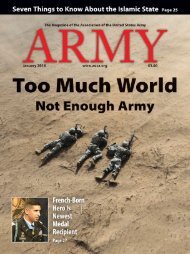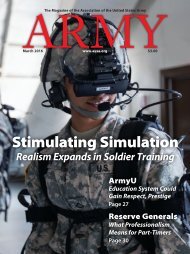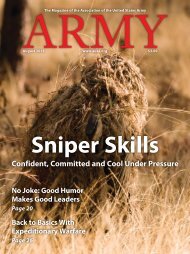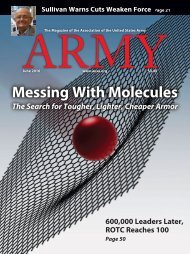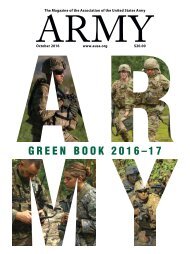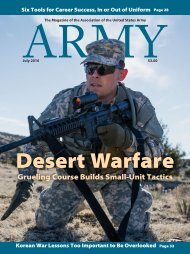Army - Kicking Tires On Jltv
Create successful ePaper yourself
Turn your PDF publications into a flip-book with our unique Google optimized e-Paper software.
Members of the 6th Squadron, 6th Cavalry Regiment,<br />
work on a helicopter in New Mexico.<br />
Establishing a designated release time<br />
was an effort to solve the soldiers’ morale<br />
issues. The solution to the slow maintenance<br />
process was to increase work hours<br />
so all tasks could be met. The way to become<br />
better at training was to require 100<br />
percent participation in all training activities.<br />
These solutions, while effective for<br />
their individual symptoms, totally contradicted<br />
each other.<br />
It is important to examine the sum of<br />
all the symptoms—which, in this case,<br />
led us to discover that the conventional<br />
modified table of organization and equipment<br />
organization structure was not<br />
compatible with current demands placed on the AMC.<br />
Address Tasks<br />
With the problem identified, applying an innovative solution<br />
should increase efficiency and morale within the unit.<br />
Given that the AMC has two primary constraints—maintenance<br />
and training—tailoring the solution to address these<br />
tasks is critical. The logical resolution would incorporate<br />
transforming the classic three-platoon concept into a twoforce<br />
configuration.<br />
The two forces would mirror one another and be on a rotational<br />
schedule; for the sake of this article, a week will be the<br />
arbitrary time. <strong>On</strong>e force would be on maintenance for a week<br />
while the other force focused on training, additional tasks and<br />
soldiers’ personal appointments.<br />
Certain portions of the company would be exempt from the<br />
organizational restructuring. These include the command section<br />
(commander, first sergeant and orderly); the production<br />
control, quality control, supply section and tech supply officers<br />
in charge/NCOs in charge; and phase teams. These sections<br />
would operate independently of the new structure to meet the<br />
demands of their positions.<br />
The two forces would operate on separate schedules in an<br />
effort to maximize productivity. The maintenance force would<br />
work from 6:30 a.m. to 5 p.m.; soldiers within the maintenance<br />
force would be given segmented meal times that match the<br />
operating hours of the dining facilities. The emphasis during<br />
meal periods would be to separate the dining schedule so all<br />
Capt. Robert C. Sprague is a student management officer and Basic<br />
Officer Leader Course instructor for Company D, 1st Battalion,<br />
145th Aviation Regiment, at Fort Rucker, Ala. Sprague attended<br />
U.S. <strong>Army</strong> Flight School at Fort Rucker and qualified as a<br />
UH-60M pilot. He served as an assistant S3 as part of a future<br />
operations cell at Fort Drum, N.Y., and deployed to Afghanistan<br />
from April 2013 to January 2014 with Fort Drum’s 2nd Battalion,<br />
10th Combat Aviation Brigade. He returned to Fort Rucker<br />
and completed the Aviation Maintenance Officers Course and<br />
Aviation Captains Career Course.<br />
soldiers could eat without letting maintenance ever come to a<br />
complete stop. Physical training would be from 4 to 5 p.m.<br />
Maintenance is the only focus of this force. Protection for<br />
the members of this force keeps them from performing other<br />
duties. In addition, personnel within this force may schedule<br />
personal appointments only on a case-by-case basis. During<br />
slower maintenance times, members of this force focus on<br />
MOS training. This schedule and protected status allow the<br />
AMC to solve the higher unit’s maintenance problems by providing<br />
a ready and guaranteed maintenance force.<br />
Areas of Focus<br />
In contrast to the maintenance force, the training force<br />
would have multiple areas of focus including required training,<br />
inspection preparation, motor pool activities, personal appointments,<br />
and additional tasks and duties. This week would<br />
provide leaders the flexibility to design a training schedule that<br />
would not hurt the unit’s maintenance tempo.<br />
The daily schedule for the training force would be from 9<br />
a.m. to 5 p.m. (standard meal periods in effect), with physical<br />
training from 6 to 7:15 a.m. It would be at the leader’s discretion<br />
to decide how fluid or rigid the training force’s schedule<br />
would be.<br />
The ideas presented here are merely a snapshot of the overall<br />
multiple-step process to usher in a fresh era in the evolution<br />
of the AMC. A quick examination of this idea demonstrates<br />
how proper problem diagnosis gives birth to a solution that<br />
would remedy all symptoms. Changing the organizational<br />
structure of an AMC would increase productivity and stability<br />
within the unit. Morale would increase as a result of soldiers’<br />
value stability and predictability in their schedules. With a<br />
dedicated maintenance force, the time it takes to complete<br />
tasks would decrease, and the higher unit’s maintenance program<br />
would improve.<br />
With a force as well as a routine block of time devoted to all<br />
things training, the quality of the training and completion rates<br />
vastly increase. Of all the ideas to foster within an organization,<br />
one of the most critical is to never discourage innovation. Without<br />
it, you are doomed to repeat the same error indefinitely. ✭<br />
U.S. <strong>Army</strong>/Staff Sgt. Candice Harrison<br />
44 ARMY ■ February 2016




